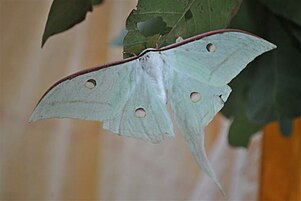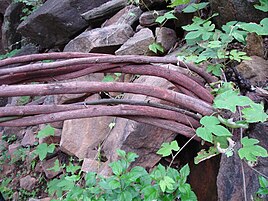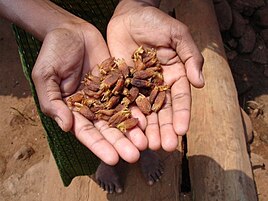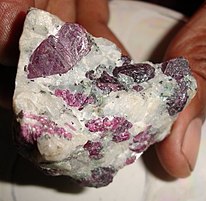Chhattisgarh
Chhattisgarh (/ˌtʃætɪzˈɡɑːr/;[6] Hindi Chattīsgaṛh, [ˈtʃʰət̪ːiːsgəɽʱ], transl. ’Thirty-Six Forts’) is a state located in the region of Central India. Formerly part of Madhya Pradesh, it was granted statehood on November 1, 2000. It is the 9th-largest state in India, with an area of 135,192 km2 (52,198 sq mi). As of 2020, it has a population of roughly 29.4 million, making it the 17th most populated state in the country.[7]
The state was formed by the partition of ten Chhattisgarhi and six Gondi-speaking districts in the southeast of Madhya Pradesh.[8][9] Its capital city is Raipur. It borders 7 states – Uttar Pradesh to the north, Madhya Pradesh to the northwest, Maharashtra to the southwest, Jharkhand to the northeast, Odisha to the east, and Telangana and Andhra to the south.[10] Currently, it comprises 28 districts.
Chhattisgarh is one of the fastest-developing states in India.[11] Its Gross State Domestic Product (GSDP) is ₹3.63 lakh crore (US$51 billion), with a per capita GSDP of ₹102,762 (US$1,400).[12] A resource-rich state, Chhattisgarh provides electricity, coal, and steel to the rest of the nation.[13]
In 2020, it again won the title of cleanest state with more than 100 Urban Local Bodies, as announced by Minister for Housing and Urban Affairs Hardeep Singh Puri following the ‘Swachh Survekshan 2020’.[14]
Administration[edit]
Chhattisgarh state consists of 5 divisions with 28 districts (one new district named “Gaurela-Pendra-Marwahi” created with effect from 10 February 2020).
Divisions[edit]
| Bastar Division | Durg Division | Raipur Division | Bilaspur Division | Surguja Division |
|---|---|---|---|---|
|
Districts[edit]
Chhattisgarh comprises 28 districts. The following are the list of the districts of Chhattisgarh State with major cities:
Major cities[edit]
| Largest cities in Chhattisgarh (2011 Census of India estimate)[36] | |||||||||||
|---|---|---|---|---|---|---|---|---|---|---|---|
| Rank | City | District | Population | ||||||||
| 1 | Raipur | Raipur | 4,063,872 | ||||||||
| 2 | Bhilai–Durg | Durg | 3,343,872 | ||||||||
| 3 | Bilaspur | Bilaspur | 2,663,629 | ||||||||
| 4 | Rajnandgaon | Rajnandgaon | 1,537,133 | ||||||||
| 5 | Raigarh | Raigarh | 1,493,984 | ||||||||
| 6 | Korba | Korba | 1,206,640 | ||||||||
| 7 | Ambikapur | Sarguja | 2,359,886 | ||||||||
| 8 | Jagdalpur | Bastar | 125,345 | ||||||||
| 9 | Chirmiri | Koriya | 100,656 | ||||||||
| 10 | Dhamtari | Dhamtari | 90,254 | ||||||||
| 11 | Mahasamund | Mahasamund | 85,000 | ||||||||
Economy[edit]
| Statistics | |
|---|---|
| GDP | ₹383,098 crore (US$54 billion) (2021–22 est.)[37] |
| GDP rank | 17th |
GDP growth | 5% (2020–21)[37] |
GDP per capita | ₹104,943 (US$1,500) (2020–21)[38] |
GDP by sector | Agriculture 26% Industry 38% Services 36% (2020–21)[37] |
| Public finances | |
| 28.3% of GSDP (2021–22 est.)[37] | |
| ₹−17,461 crore (US$−2.4 billion) (4.56% of GSDP) (2021–22 est.)[37] | |
| Revenues | ₹79,645 crore (US$11 billion) (2021–22 est.)[37] |
| Expenses | ₹102,483 crore (US$14 billion) (2021–22 est.)[37] |
All values, unless otherwise stated, are in US dollars. | |
Chhattisgarh’s nominal gross state domestic product (GSDP) is estimated at ₹3.26 lakh crore (US$46 billion) in 2018–19, the 17th largest state economy in India. The economy of Chhattisgarh recorded a growth rate of 6.7% in 2017–18.[37] Chhattisgarh’s success factors in achieving high growth rate are growth in agriculture and industrial production.
Tea Production[edit]
Chhattisgarh State is ranked as the 17th-largest tea-producing state in India. The districts of Jashpur and Surguja are favorable tea production areas. In Jashpur district, the first tea plantation, Brahmnishthajaya Sogara Ashram was established under the direction of Pujya Pad Gurupad. Tea production started after two years at the Sogara Ashram. A tea processing unit was established in Sogara Ashram and the unit name set as the Aghor Tea Processing Plant. The forestry department has also started a tea plantation motivated by the Sogara Ashram. In Surguja district, a tea nursery is being developed by the Margdarshan Sansthan Agriculture College in Ambikapur, Surguja.
Agriculture[edit]
Agriculture is counted as the chief economic occupation of the state. According to a government estimate, net sown area of the state is 4.828 million hectares and the gross sown area is 5.788 million hectares.[39] Horticulture and animal husbandry also engage a major share of the total population of the state.[40] About 80% of the population of the state is rural and the main livelihood of the villagers is agriculture and agriculture-based small industry.
The majority of the farmers are still practicing the traditional methods of cultivation, resulting in low growth rates and productivity. The farmers have to be made aware of modern technologies suitable to their holdings. Providing adequate knowledge to the farmers is essential for better implementation of the agricultural development plans and to improve productivity.[41]
Considering this and a very limited irrigated area, the productivity of not only rice but also other crops is low, hence the farmers are unable to obtain economic benefits from agriculture and it has remained as subsistence agriculture till now.
Agricultural products[edit]
The main crops are rice, maize,[42] kodo-kutki and other small millets and pulses (tuar[43] and kulthi); oilseeds, such as groundnuts (peanuts), soybeans[44] and sunflowers, are also grown. In the mid-1990s, most of Chhattisgarh was still a monocrop belt. Only one-fourth to one-fifth of the sown area was double-cropped. When a very substantial portion of the population is dependent on agriculture, a situation where nearly 80% of a state’s area is covered only by one crop, immediate attention to turn them into double crop areas is needed. Also, very few cash crops are grown in Chhattisgarh, so there is a need to diversify the agriculture produce towards oilseeds and other cash crops. Chhattisgarh is also called the “rice bowl of central India”.[39]
Bastar beer prepared from Sulfi
Industrial sector[edit]
Power sector[edit]
Chhattisgarh is one of the few states of India where the power sector is effectively developed. Based on the current production of surplus electric power, the position of the State is comfortable and profitable. The Chhattisgarh State Electricity Board (CSEB) is in a strong position to meet the electricity requirement of the state and is in good financial health. According to Central Electricity Authority (CEA), Chhattisgarh provides electricity to several other states because of surplus production.[45]
In Chhattisgarh, National Thermal Power Corporation Limited (|NTPC) has Sipat Thermal Power Station with a capacity of 2,980 MW at Sipat, Bilaspur; LARA Super Thermal Power Station with a nameplate capacity of 1600MW and Korba Super Thermal Power Station with a capacity of 2,600 MW at Korba, while CSEB’s units have a thermal capacity of 1,780 MW and hydel capacity of 130 MW. Apart from NTPC and CSEB, there are a number of private generation units of large and small capacity. The state government has pursued a liberal policy with regard to captive generation which has resulted in a number of private companies coming up.[46]
The state has a potential of 61,000 MW of additional thermal power in terms of availability of coal for more than 100 years and more than 2,500 MW hydel capacity. To use this vast potential, substantial additions to the existing generation capacity are already underway.[46]
Steel sector[edit]
The steel industry is one of the biggest heavy industries of Chhattisgarh. Bhilai Steel Plant, Bhilai operated by SAIL, with a capacity of 5.4 million tonnes per year, is regarded as a significant growth indicator of the state. More than 100 steel rolling mills, 90 sponge iron plants and ferro-alloy units are in Chhattisgarh. Along with Bhilai, today Raipur, Bilaspur, Korba and Raigarh have become the steel hub of Chhattisgarh. Today, Raipur has become the centre of the steel sector, the biggest market for steel in India.[47]
Aluminium sector[edit]
The aluminium industry of Chhattisgarh was established by Bharat Aluminium Company Limited, which has a capacity of around 5,700,000 tonnes each year.[47]
Natural resources[edit]
Forest[edit]
Forests occupy 41.33% of the total area (as per the latest report by the Indian Forest Service) and the rich forest resources include wood, tendu leaves, honey and lac. Approximately 3% is under very dense forest, 25.97% is moderately dense, 12.28% is open forest and 0.09% is scrub.
Mineral deposits[edit]
Chhattisgarh is rich in minerals. It produces 50% of the country’s total cement production. It has the highest output of coal in the country with second-highest reserves. It is third in iron ore production and first in tin production. Limestone, dolomite and bauxite are abundant. It is the only tin ore-producing state in India. Other commercially extracted minerals include corundum, garnet, quartz, marble, alexandrite and diamonds.
Information and technologies[edit]
In recent years, Chhattisgarh is also receiving exposure in information technology (IT) projects and consultancy. Its government is also promoting IT and has set up a body to take care of IT solutions. The body, known as CHiPS, is providing large IT projects such as Choice, Swan, and so forth.
Major companies[edit]
Major companies with a presence in the state include:
- Metal: Bhilai Steel Plant, Jindal Steel and Power, Bharat Aluminium Company
- Oil: Indian Oil Corporation, Hindustan Petroleum Corporation Limited
- Mining: NMDC, South Eastern Coalfields
- Power : NTPC, Lanco Infratech, KSK Energy Ventures, Jindal Power Limited
Exports[edit]
Chhattisgarh’s total exports were US$353.3 million in 2009–10. Nearly 75% of exports comes from Bhilai and the remaining from Urla, Bhanpuri, and Sirgitti. The major exports products include steel, handicrafts, handlooms, blended yarn, food and agri-products, iron, aluminium, cement, minerals, and engineering products. CSIDC (Chhattisgarh State Industrial Development Corporation Limited) is the nodal agency of the government of Chhattisgarh for export promotion in the state.
Media[edit]
Mainline print media present in Chhattisgarh are Hari Bhoomi,[48] Dainik Bhaskar, Patrika, Navabharat, and Nai Duniya.













